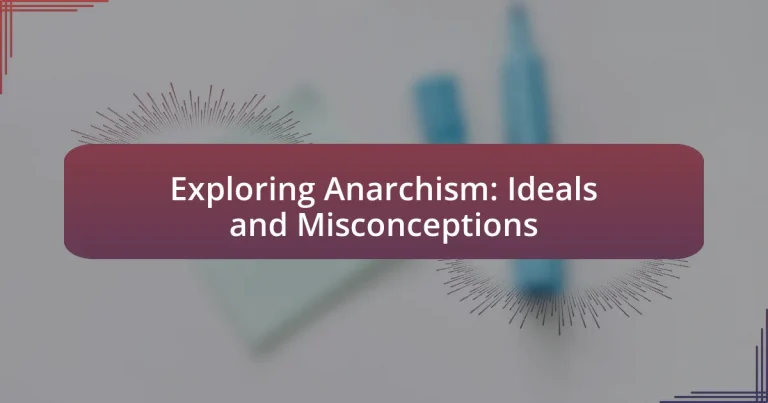Anarchism is a political philosophy advocating for a society without hierarchical authority, emphasizing self-governance and voluntary institutions. Originating in the 19th century, it critiques capitalism and state power, with key figures like Pierre-Joseph Proudhon and Mikhail Bakunin shaping its foundational principles. The article explores the historical roots of anarchism, its core principles, various schools of thought, and common misconceptions, particularly the erroneous association with chaos and violence. It also examines the role of anarchism in contemporary social movements and offers practical steps for individuals to engage with anarchist ideals today.

What is Anarchism?
Anarchism is a political philosophy that advocates for a society without hierarchical authority, emphasizing self-governed societies based on voluntary institutions. This ideology opposes all forms of coercive control, including the state, and promotes the idea that individuals can organize themselves freely without imposed structures. Historically, anarchism has roots in the 19th century, with figures like Pierre-Joseph Proudhon, who famously declared that “property is theft,” highlighting the critique of capitalism and state power. Anarchism encompasses various schools of thought, including anarcho-communism and anarcho-syndicalism, each proposing different methods for achieving a stateless society.
How did Anarchism originate?
Anarchism originated in the 19th century as a political philosophy advocating for a society without hierarchical authority. The term “anarchism” was first used by Pierre-Joseph Proudhon in 1840, who argued against the state and capitalism, promoting mutualism and voluntary cooperation. This ideology gained traction during the social upheavals of the time, influenced by the Industrial Revolution and the rise of socialist movements. Anarchism’s roots can be traced to earlier thinkers like William Godwin and the French Revolution, which emphasized individual liberty and anti-authoritarianism.
What historical events influenced the development of Anarchism?
The development of Anarchism was significantly influenced by the French Revolution, which introduced ideas of liberty and equality that challenged traditional authority. The revolution’s radical phase, particularly the Reign of Terror, highlighted the potential for state power to become oppressive, prompting thinkers like Pierre-Joseph Proudhon to advocate for a society without government. Additionally, the Industrial Revolution created stark class divisions and labor exploitation, leading to the rise of socialist and anarchist movements that sought to address these inequalities. The 1848 Revolutions across Europe further galvanized anarchist thought, as various uprisings against oppressive regimes demonstrated the desire for self-governance and autonomy. These historical events collectively shaped the foundational principles of Anarchism, emphasizing anti-authoritarianism and the pursuit of a stateless society.
Who are the key figures in the history of Anarchism?
Key figures in the history of Anarchism include Pierre-Joseph Proudhon, Mikhail Bakunin, and Emma Goldman. Pierre-Joseph Proudhon is often regarded as the first anarchist thinker, famously declaring that “property is theft” in his 1840 work “What is Property?” Mikhail Bakunin, a prominent Russian revolutionary, emphasized the importance of collective action and anti-authoritarianism, influencing the development of anarchist theory in the 19th century. Emma Goldman, an influential anarchist and feminist, advocated for individual freedom and social justice, contributing significantly to anarchist thought in the early 20th century through her writings and activism. These figures collectively shaped the foundational ideas and practices of Anarchism, establishing its relevance in political discourse.
What are the core principles of Anarchism?
The core principles of Anarchism include anti-authoritarianism, voluntary cooperation, and the rejection of hierarchical structures. Anarchism advocates for a society organized without coercive institutions, emphasizing individual freedom and mutual aid. Historical figures like Mikhail Bakunin and Peter Kropotkin have articulated these principles, arguing that social order can emerge organically through voluntary associations rather than imposed authority. Anarchism also promotes direct action and grassroots organizing as means to achieve social change, reflecting its foundational belief in self-governance and community empowerment.
How does Anarchism define authority and power?
Anarchism defines authority as a coercive force that undermines individual freedom and autonomy. In this ideology, power is viewed as inherently oppressive when it is centralized and hierarchical, leading to domination over individuals rather than serving their interests. Anarchists argue that legitimate authority must be based on voluntary consent and mutual aid, contrasting with traditional forms of power that rely on control and subjugation. Historical examples include the anarchist movements during the Spanish Civil War, which sought to establish decentralized, egalitarian structures that empowered individuals and communities without coercive authority.
What role does individual freedom play in Anarchist thought?
Individual freedom is central to Anarchist thought, as it emphasizes the importance of autonomy and self-determination for individuals. Anarchists argue that true freedom can only be achieved in the absence of coercive institutions, such as the state, which they believe restrict individual liberties. Historical figures like Mikhail Bakunin and Emma Goldman have articulated that individual freedom is not merely the absence of restraint but also the presence of conditions that allow individuals to pursue their own paths without oppression. This perspective is supported by the idea that social hierarchies and authority undermine personal freedom, leading to a call for a society based on voluntary cooperation and mutual aid.
What are the different schools of Anarchism?
The different schools of Anarchism include Anarcho-Communism, Anarcho-Syndicalism, Individualist Anarchism, Mutualism, and Green Anarchism. Anarcho-Communism advocates for a stateless, classless society where resources are shared communally. Anarcho-Syndicalism focuses on direct action and workers’ self-management through trade unions. Individualist Anarchism emphasizes personal autonomy and the rights of the individual against coercive institutions. Mutualism promotes a society where individuals exchange goods and services based on mutual consent and reciprocity. Green Anarchism integrates environmental concerns with anarchist principles, advocating for ecological sustainability and anti-capitalism. Each school presents distinct perspectives on the organization of society and the role of authority.
What distinguishes Anarcho-communism from Anarcho-capitalism?
Anarcho-communism and anarcho-capitalism are distinguished primarily by their views on property and economic organization. Anarcho-communism advocates for the abolition of private property and the establishment of a communal system where resources are shared collectively, aiming for a classless society. In contrast, anarcho-capitalism supports private property rights and free markets, emphasizing individual ownership and voluntary exchanges as the foundation of society. This fundamental difference in economic philosophy reflects their divergent goals: anarcho-communism seeks equality and communal welfare, while anarcho-capitalism prioritizes individual freedom and market autonomy.
How do various Anarchist movements approach social organization?
Various Anarchist movements approach social organization through decentralized, non-hierarchical structures that prioritize voluntary cooperation and mutual aid. For instance, anarcho-communism advocates for communal ownership of resources and decision-making through consensus, as seen in historical examples like the Spanish Revolution of 1936, where collectives managed agriculture and industry without centralized authority. Anarcho-syndicalism emphasizes direct action and workers’ self-management, exemplified by the labor movements in early 20th-century Europe, which sought to empower workers through federated unions. Additionally, individualist anarchism focuses on personal autonomy and free association, promoting a society where individuals freely collaborate without coercive institutions. These approaches collectively illustrate the diverse strategies within Anarchist thought aimed at creating egalitarian social structures.

What misconceptions exist about Anarchism?
A common misconception about anarchism is that it advocates for chaos and lawlessness. In reality, anarchism seeks to establish a society without hierarchical authority, emphasizing voluntary cooperation and mutual aid among individuals. Historical examples, such as the anarchist movements during the Spanish Civil War, demonstrate that anarchists can organize complex social structures and communities based on egalitarian principles, rather than disorder. Additionally, many anarchists promote the idea of self-governance and decentralized decision-making, which contradicts the notion of an absence of order.
Why do people associate Anarchism with chaos?
People associate Anarchism with chaos primarily due to misconceptions about its principles and historical representations. Anarchism advocates for a stateless society where individuals govern themselves, which is often misinterpreted as a lack of order. This misunderstanding is reinforced by media portrayals and historical events, such as riots or protests, where anarchist symbols are present, leading to the perception that Anarchism inherently promotes disorder. Additionally, the term “anarchy” in popular culture is frequently linked to lawlessness, further solidifying the association with chaos rather than the intended vision of voluntary cooperation and mutual aid that many anarchists espouse.
How has media representation shaped the perception of Anarchism?
Media representation has significantly shaped the perception of Anarchism by often portraying it as synonymous with chaos and violence. This portrayal stems from sensationalist media coverage of protests and riots, where anarchists are frequently depicted as instigators of disorder. For instance, during events like the 1999 Seattle WTO protests, media outlets emphasized violent clashes, reinforcing negative stereotypes about anarchists as extremists. Additionally, films and literature often depict anarchism in a dystopian context, further entrenching misconceptions. This skewed representation has led to a general public perception that associates anarchism with lawlessness rather than its foundational principles of anti-authoritarianism and voluntary cooperation.
What are the realities of Anarchist societies compared to common beliefs?
Anarchist societies often operate under principles of voluntary cooperation and mutual aid, contrasting with the common belief that they lead to chaos and disorder. Historical examples, such as the anarchist regions during the Spanish Civil War (1936-1939), demonstrate that these societies can effectively organize labor, education, and community services without centralized authority. In these instances, collective decision-making and direct democracy were employed, resulting in increased productivity and social cohesion. Additionally, studies on contemporary anarchist movements, like those in Rojava, show that decentralized governance can promote gender equality and local autonomy, further challenging the misconception that anarchism equates to lawlessness.
How does Anarchism relate to violence and crime?
Anarchism is often associated with violence and crime due to historical instances where anarchist movements engaged in direct action, including sabotage and insurrection. However, many anarchists advocate for non-violent methods of social change, emphasizing mutual aid and voluntary cooperation. For example, during the Spanish Civil War, anarchists organized communities based on these principles, demonstrating that anarchism can function without resorting to violence. This duality illustrates that while some factions may resort to violent tactics, the core ideology of anarchism promotes a society free from coercive authority, which can manifest in both peaceful and violent forms depending on the context.
What evidence contradicts the notion that Anarchism promotes violence?
Anarchism does not inherently promote violence, as evidenced by numerous historical examples of peaceful anarchist movements. For instance, the Spanish Revolution of 1936 showcased anarchist collectives that prioritized mutual aid, cooperation, and non-violent resistance against fascism, rather than violence. Additionally, the principles of anarchism emphasize voluntary association and self-governance, which often lead to peaceful community organization rather than conflict. Research by scholars such as Ruth Kinna highlights that many anarchist theorists advocate for non-violent methods to achieve social change, further contradicting the notion that anarchism is synonymous with violence.
How do Anarchists advocate for non-violent resistance?
Anarchists advocate for non-violent resistance primarily through the promotion of direct action, mutual aid, and grassroots organizing. These methods emphasize collective action without resorting to violence, aiming to dismantle oppressive systems while fostering community solidarity. Historical examples include the non-violent protests during the Spanish Civil War, where anarchists organized to resist fascism through peaceful means, and the use of strikes and boycotts as tools for social change. Additionally, anarchist theorists like Peter Kropotkin have emphasized the importance of cooperation and voluntary association, arguing that non-violent methods can effectively challenge authority and create alternative social structures.
What are the economic misconceptions surrounding Anarchism?
Economic misconceptions surrounding Anarchism include the belief that it inherently leads to chaos and economic collapse. Critics often argue that without a centralized authority, there would be no regulation of markets, resulting in exploitation and inequality. However, historical examples, such as the anarchist territories during the Spanish Civil War, demonstrate that decentralized economies can function effectively, with cooperative enterprises and mutual aid networks thriving. Additionally, anarchism advocates for voluntary associations and self-management, which can lead to more equitable distribution of resources, countering the notion that it promotes disorder.
How do Anarchists envision economic systems without centralized control?
Anarchists envision economic systems without centralized control through decentralized, cooperative models that prioritize mutual aid and voluntary association. They advocate for structures such as worker cooperatives, community-based resource management, and barter systems, which operate independently of state intervention. Historical examples include the Spanish Revolution (1936-1939), where anarchists implemented collectivized agriculture and industry, demonstrating the feasibility of self-managed economies. These systems emphasize direct democracy, where individuals participate in decision-making processes, ensuring that economic activities reflect the needs and desires of the community rather than a centralized authority.
What examples exist of successful Anarchist economic practices?
Successful anarchist economic practices include the Spanish Revolution of 1936, where anarchist collectives managed agriculture and industry, leading to increased productivity and social equity. In these collectives, workers organized themselves without hierarchical structures, demonstrating effective self-management. Additionally, the Zapatista communities in Chiapas, Mexico, have implemented autonomous economic practices that prioritize local needs and sustainability, showcasing a successful model of anarchist economics in contemporary society. These examples illustrate how anarchist principles can lead to viable economic systems that emphasize cooperation and mutual aid.

How can one engage with Anarchist ideals today?
One can engage with Anarchist ideals today by participating in grassroots organizing and mutual aid initiatives that reflect principles of self-governance and voluntary cooperation. These activities often include community-based projects that prioritize direct action, such as food cooperatives, community gardens, and local skill-sharing workshops. Historical examples, such as the Spanish Civil War’s anarchist collectives, demonstrate the effectiveness of decentralized, non-hierarchical structures in fostering community resilience and autonomy. Engaging with literature from contemporary anarchist theorists, such as David Graeber or Silvia Federici, can also provide insights into applying these ideals in modern contexts.
What practical steps can individuals take to explore Anarchism?
Individuals can explore Anarchism by reading foundational texts, engaging in discussions, and participating in local activist groups. Foundational texts such as “The Conquest of Bread” by Peter Kropotkin and “Anarchism: A Very Short Introduction” by Colin Ward provide essential insights into anarchist theory and practice. Engaging in discussions with like-minded individuals or attending lectures can deepen understanding and challenge misconceptions. Additionally, joining local activist groups or online forums allows individuals to experience anarchist principles in action, fostering a practical understanding of community organization and mutual aid. These steps are supported by the historical context of anarchism, which emphasizes direct action and grassroots organizing as key components of its philosophy.
How can community organizing reflect Anarchist principles?
Community organizing can reflect Anarchist principles by promoting decentralized decision-making and empowering individuals to take collective action without hierarchical authority. Anarchism advocates for self-governance and mutual aid, which are foundational elements in community organizing efforts that prioritize grassroots participation and consensus-building. Historical examples, such as the Spanish Civil War’s anarchist collectives, demonstrate how communities can effectively manage resources and make decisions collaboratively, embodying the core tenets of Anarchism. These practices illustrate that community organizing not only aligns with but actively manifests Anarchist ideals in real-world scenarios.
What resources are available for learning about Anarchism?
Books, articles, and online courses are key resources for learning about Anarchism. Notable books include “Anarchism: A Very Short Introduction” by Colin Ward, which provides a concise overview of anarchist thought, and “The Conquest of Bread” by Peter Kropotkin, which outlines the economic principles of anarchism. Academic journals such as “Anarchist Studies” publish peer-reviewed articles that explore various aspects of anarchist theory and practice. Additionally, websites like the Anarchist Library offer a vast collection of texts and resources for free access. These resources collectively provide a comprehensive foundation for understanding the principles and history of Anarchism.
How can Anarchism influence contemporary social movements?
Anarchism can influence contemporary social movements by promoting decentralized organization and direct action. This influence is evident in movements such as Occupy Wall Street and Black Lives Matter, where participants emphasize horizontal decision-making structures rather than hierarchical leadership. Anarchist principles advocate for self-management and mutual aid, which have been adopted by various grassroots organizations to challenge systemic inequalities. Historical examples, such as the Spanish Civil War, demonstrate how anarchist collectives effectively mobilized communities for social change, providing a framework that contemporary movements can emulate to foster solidarity and empower marginalized voices.
What role does Anarchism play in current activism?
Anarchism plays a significant role in current activism by promoting decentralized, grassroots movements that challenge state authority and advocate for social justice. This ideology influences various contemporary social movements, including anti-globalization protests, environmental activism, and labor rights campaigns, emphasizing direct action and mutual aid as core principles. For instance, the Occupy Wall Street movement in 2011 showcased anarchist principles by organizing without centralized leadership and focusing on collective decision-making. Additionally, anarchist groups often collaborate with other activist organizations to address issues such as police brutality and economic inequality, demonstrating their relevance in today’s socio-political landscape.
How can Anarchist thought contribute to discussions on social justice?
Anarchist thought can significantly contribute to discussions on social justice by advocating for the dismantling of hierarchical structures that perpetuate inequality. This perspective emphasizes the importance of voluntary cooperation and mutual aid, which can lead to more equitable social arrangements. Historical examples, such as the Spanish Revolution of 1936, illustrate how anarchist principles were applied to create egalitarian communities that prioritized workers’ rights and social equity. By challenging state authority and promoting grassroots organizing, anarchism encourages marginalized voices to participate actively in shaping their own destinies, thereby enhancing the discourse on social justice.
What are the best practices for applying Anarchist principles in daily life?
The best practices for applying Anarchist principles in daily life include fostering mutual aid, promoting direct democracy, and engaging in non-hierarchical relationships. Mutual aid emphasizes cooperation and support within communities, as seen in various grassroots organizations that provide resources without reliance on state structures. Direct democracy encourages individuals to participate actively in decision-making processes, exemplified by community assemblies where everyone has a voice. Non-hierarchical relationships challenge traditional power dynamics, promoting equality and respect in personal and professional interactions, as demonstrated by many cooperative businesses that operate without a top-down management structure. These practices reflect the core tenets of Anarchism, advocating for a society based on voluntary cooperation and self-governance.





